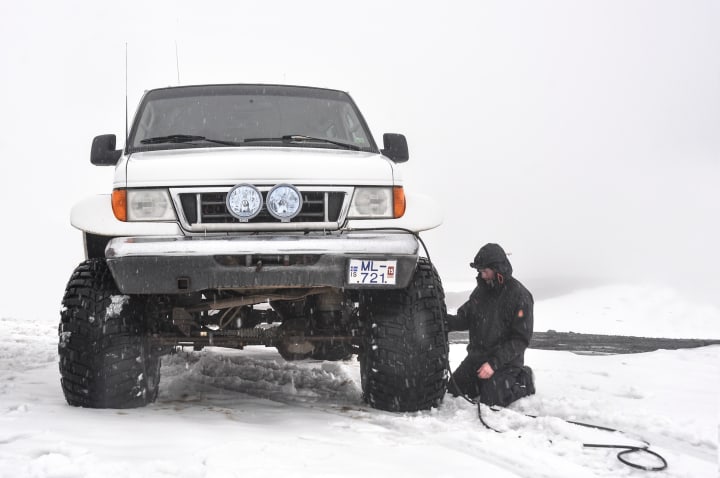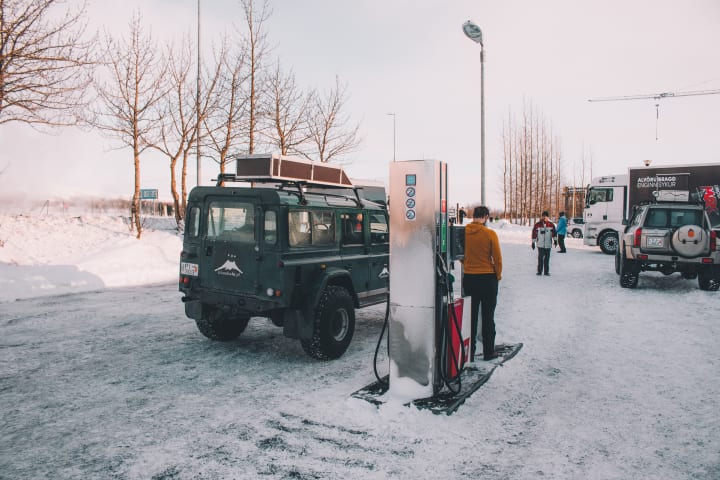8 Necessary Winter Driving Tips to Keep You Safe
Winter brings a host of hazards to the road, so it’s always a good idea to know any and all winter driving tips to keep you safe.
Driving at any time of year poses its own risks, but we all know that driving during the winter can be especially hazardous. From the slippery conditions of icy roads to the limited visibility of snowstorms, driving in the winter can be stressful, and it demands our full attention and preparation in order to stay safe. Though driving in wintry conditions may seem daunting, there are certain measures we can put in place to make sure we are prioritizing safety. Because we all want to make sure we are keeping ourselves and those around us out of harm’s way, it’s important to learn a few winter driving tips to keep you safe no matter what the cold weather throws your way.
Check the weather.

It may seem obvious, but checking the weather is vital when driving in the wintertime. The last thing you want is to end up in an unexpected snowstorm or suddenly discover a bridge has completely iced over, so look at the weather conditions before making your trip. If you can see that inclement weather conditions are approaching, try your best to schedule your trip around them. While it may seem inconvenient, delaying your trip to avoid poor weather conditions is much safer than trying to take on snow and ice yourself.
Know what your vehicle is capable of.

Familiarize yourself with the features of your vehicle that might come in handy in wintry conditions. For example, traction control, electronic stability control, and an anti-lock braking system are features that many cars now come equipped with, and its important to know how these features operate. Know that these features might feel different while driving; for example, anti-lock brakes might vibrate when engaged, and you should continue to put pressure on the brake pedal when sensing these vibrations. It’s important to know what brake system and special features your vehicle might have so that you can prepare to use them when you need them the most.
Make sure you have the right tires.

If you expect to encounter wintry conditions frequently, it is worth it to invest in winter tires, as the deeper and more flexible tread increases traction and reduces your risk of losing control of the vehicle. Additionally, the rubber compound used in winter tires increases the tire’s grip, so even when driving on dry pavement in cold weather, snow tires beat out all-season tires. If you opt to use all-season tires, make sure to monitor the tread consistently, and once the tread has been worn down to a depth of 2/32’’, it’s time to change the tire.
Check your vehicle.

Before you pull out of the driveway, do a quick but thorough inspection of your vehicle to make sure it’s ready to make whatever trip you’re planning to take. During this check, you should make sure the exhaust pipe is not blocked by snow or ice, as a clogged exhaust pipe can lead to carbon monoxide poisoning. You should also check your tire pressure and tread to make sure your tires are ready to brave the roads, as dropping temperatures correspond to a decrease in tire pressure. The cold weather will also affect your car battery’s performance, so make sure you’ve got at least a 75 percent charge, especially if you’re taking a longer trip. Also, you should make sure that your windshield wipers work effectively, because the last thing you want is old wipers pushing around snow on the windshield while driving through a storm. Lastly, check to ensure that your car has enough oil, antifreeze, and washer fluid before you hit the roads.
Prepare a winter kit for your vehicle.

As soon as the cold of winter begins to hit, it’s a good idea to make sure your vehicle is stocked up with any items you might need to combat any difficult conditions the cold weather brings. In addition to having essentials for your car emergency kit, with items such as jumper cables, emergency flares, and a flashlight (which you should keep in your car your car year-round), you should keep items like an ice scraper, broom, and snow shovel in your car. You can also keep a blanket in your car to stay warm in the case of an emergency.
If you’re taking a longer trip, it’s also a good idea to bring some non-perishable food items on the off chance that you find yourself stuck in a remote area and have to wait for emergency assistance.
Keep your gas tank full.

A full tank of gas not only gives you peace of mind in terms of being able to arrive at your destination, but it also has some added benefits specifically in the colder months of the year. A full tank of gas increases the weight of your car, thereby providing more traction when driving in icy conditions. Additionally, if your fuel level is low, your fuel tank is at a greater risk of forming condensation, and in the winter, if this condensation in the fuel line freezes, it can prevent your vehicle from starting. Try to keep your gas tank at least half-full at all times throughout the winter to avoid any trouble with the fuel lines.
Take extra precautions while on the road.

Because the cold can bring so many potential threats to the road, it’s important to make adjustments to your typical driving style in order to stay safe. Increase your following distance so that you have more time to react if you or the car in front of you suddenly slips on a patch of ice. If you do slip on ice, don’t slam on your brakes; apply gradual pressure if you have anti-lock brakes, and pump your brakes if you use an alternative braking system. Avoid using cruise control, and try to accelerate and decelerate more slowly than you would normally. Remember that flooring the gas pedal when driving on snow will only make your wheels spin, so build up speed gradually. These tips for driving in snow not only protect you, but also prevent damage to your vehicle and keep it running smoothly.
Know how to handle black ice.

When the temperature drops below freezing, the likelihood of encountering black ice on the road skyrockets. While hitting a patch of black ice can be scary, it’s important to know how to respond once your vehicle makes contact:
- Don’t suddenly correct your steering or slam on the brakes. This may feel like the natural solution to the problem, but it’s important to fight these instincts and stay calm.
- While you shouldn’t slam on the brakes, you should naturally decelerate by removing your foot from the gas pedal completely.
- Gently guide your vehicle towards clear patches of the road. If you have fully lost control of the car, pump the brakes lightly while aiming towards a clear patch.
When driving in the wintertime, it’s critical to stay vigilant of the road conditions, so stay alert and try to identify black ice so you can guide your vehicle around it.
These safety tips can make a world of difference when you find yourself facing the seasonal challenges of winter. Staying aware of the hazards of wintry conditions and preparing your vehicle to face them is the only way to keep yourself and anyone else using roadways safe. Don’t underestimate the risk of driving on snow, ice, or slush, and take every precaution when braving colder weather and its associated perils. As temperatures start to drop, keep these winter driving tips to keep you safe in mind to prepare yourself for the winter months to come.






Comments
There are no comments for this story
Be the first to respond and start the conversation.